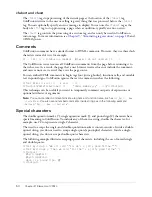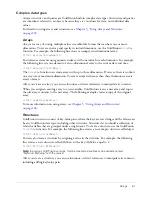
Strings
61
Complex data types
Arrays, structures, and queries are ColdFusion built-in complex data types. Structures and queries
are sometimes referred to as objects, because they are containers for data, not individual data
values.
For details on using arrays and structures, see
Chapter 5, “Using Arrays and Structures,”
on page 103
.
Arrays
Arrays
are a way of storing multiple values in a table-like format that can have one or more
dimensions. To create an array and specify its initial dimensions, use the ColdFusion
ArrayNew
function. For example, the following line creates an empty two-dimensional array:
<cfset myarray=ArrayNew(2)>
You reference elements using numeric indexes, with one index for each dimension. For example,
the following line sets one element of a two-dimensional array to the current date and time:
<cfset myarray[1][2]=Now()>
The
ArrayNew
function can create arrays with up to three dimensions. However, there is no limit
on array size or maximum dimension. To create arrays with more than three dimensions, create
arrays of arrays.
After you create an array, you can use functions or direct references to manipulate its contents.
When you assign an existing array to a new variable, ColdFusion creates a new array and copies
the old array’s contents to the new array. The following example creates a copy of the original
array:
<cfset newArray=myArray>
For more information on using arrays, see
Chapter 5, “Using Arrays and Structures,”
on page 103
.
Structures
ColdFusion
structures
consist of key-value pairs, where the keys are text strings and the values can
be any ColdFusion data type, including other structures. Structures let you build a collection of
related variables that are grouped under a single name. To create a structure, use the ColdFusion
StructNew
function. For example, the following line creates a new, empty, structure called
depts
:
<cfset depts=StructNew()>
You can also create a structure by assigning a value in the structure. For example, the following
line creates a new structure called
MyStruct
with a key,
MyValue
, equal to 2:
<cfset MyStruct.MyValue=2>
Note:
In previous ColdFusion versions, this line created a Variables scope variable named
"MyStruct.MyValue" with the value 2.
After you create a structure, you can use functions or direct references to manipulate its contents,
including adding key/value pairs.
Содержание ColdFusion MX
Страница 1: ...Developing ColdFusion MX Applications...
Страница 22: ...22 Contents...
Страница 38: ......
Страница 52: ...52 Chapter 2 Elements of CFML...
Страница 162: ......
Страница 218: ...218 Chapter 10 Writing and Calling User Defined Functions...
Страница 250: ...250 Chapter 11 Building and Using ColdFusion Components...
Страница 264: ...264 Chapter 12 Building Custom CFXAPI Tags...
Страница 266: ......
Страница 314: ...314 Chapter 14 Handling Errors...
Страница 344: ...344 Chapter 15 Using Persistent Data and Locking...
Страница 349: ...About user security 349...
Страница 357: ...Security scenarios 357...
Страница 370: ...370 Chapter 16 Securing Applications...
Страница 388: ...388 Chapter 17 Developing Globalized Applications...
Страница 408: ...408 Chapter 18 Debugging and Troubleshooting Applications...
Страница 410: ......
Страница 426: ...426 Chapter 19 Introduction to Databases and SQL...
Страница 476: ...476 Chapter 22 Using Query of Queries...
Страница 534: ...534 Chapter 24 Building a Search Interface...
Страница 556: ...556 Chapter 25 Using Verity Search Expressions...
Страница 558: ......
Страница 582: ...582 Chapter 26 Retrieving and Formatting Data...
Страница 668: ......
Страница 734: ...734 Chapter 32 Using Web Services...
Страница 760: ...760 Chapter 33 Integrating J2EE and Java Elements in CFML Applications...
Страница 786: ...786 Chapter 34 Integrating COM and CORBA Objects in CFML Applications...
Страница 788: ......
Страница 806: ...806 Chapter 35 Sending and Receiving E Mail...
















































